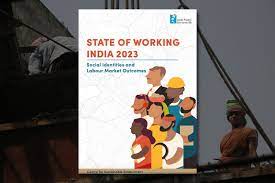State Of Working India 2023 : Report

Azim Premji University’s Centre for Sustainable Employment has released the Report titled- “State of Working India 2023” highlighting the State of Indian workforce.
- It covers unemployment rates, women’s participation, intergenerational mobility, and caste-wise workforce dynamics.
- The report used various data sources like surveys conducted by the National Statistical Office including Employment-Unemployment Surveys and Periodic Labour Force Surveys along with the India Working Survey.
Highlights of the Report:
- After stagnating since the 1980s, the share of workers with regular wage or salaried work started increasing in 2004, going from 18% to 25% for men and 10% to 25% for women.
- Between 2004 and 2017, around 3 million regular wage jobs were created annually. Between 2017 and 2019 this jumped to 5 million per year.
- Since 2019, the pace of regular wage jobs creation has decreased due to the growth slowdown and the pandemic.
- In 2004, salaried women workers earned 70% of what men earned.
- By 2017 the gap had reduced and women earned 76% of what men did. Since then the gap has remained constant till 2021-22.
- The overall unemployment rate reduced to 6.6% in 2021-22 from 8.7% in 2017-18.
- However, for graduates under the age of 25, the unemployment rate was strikingly high at 42.3%.
- In contrast, those completing higher secondary education had a lower unemployment rate of 21.4%.
- Post the Covid-19 Pandemic, 60% of women were self-employed compared to 50% before.
- However, this increase in workforce participation was accompanied by a decline in self-employment earnings, reflecting the pandemic’s distressing impact.
- Intergenerational upward mobility has shown an upward trend, indicating socio-economic progress.
- 75.6 % of SC/ST men in casual wage work also had sons involved in casual wage work in 2018.
- There are changes in caste-wise workforce participation over the years.
- The share of SC workers in casual wage work has significantly reduced, but this reduction is more pronounced in the general caste category.
- For instance, in 2021, 40% of SC workers were involved in casual employment as compared to 13% of general caste workers.
- Furthermore, around 22 % of SC workers were regular wage workers as opposed to 32% of general caste workers.
- Economic growth has not proportionately translated into job creation, with the capacity to generate jobs declining as GDP (Gross Domestic Product) increases.
- The transition from agriculture to other sectors has not ensured a shift to salaried employment.
- Despite the aspiration for salaried employment, the majority of salaried work is informal, lacking contracts and benefits. Good salaried jobs with proper benefits are becoming less prominent.
- Graduate unemployment could be attributed to high aspirations and wage demands that the economy may not meet.




